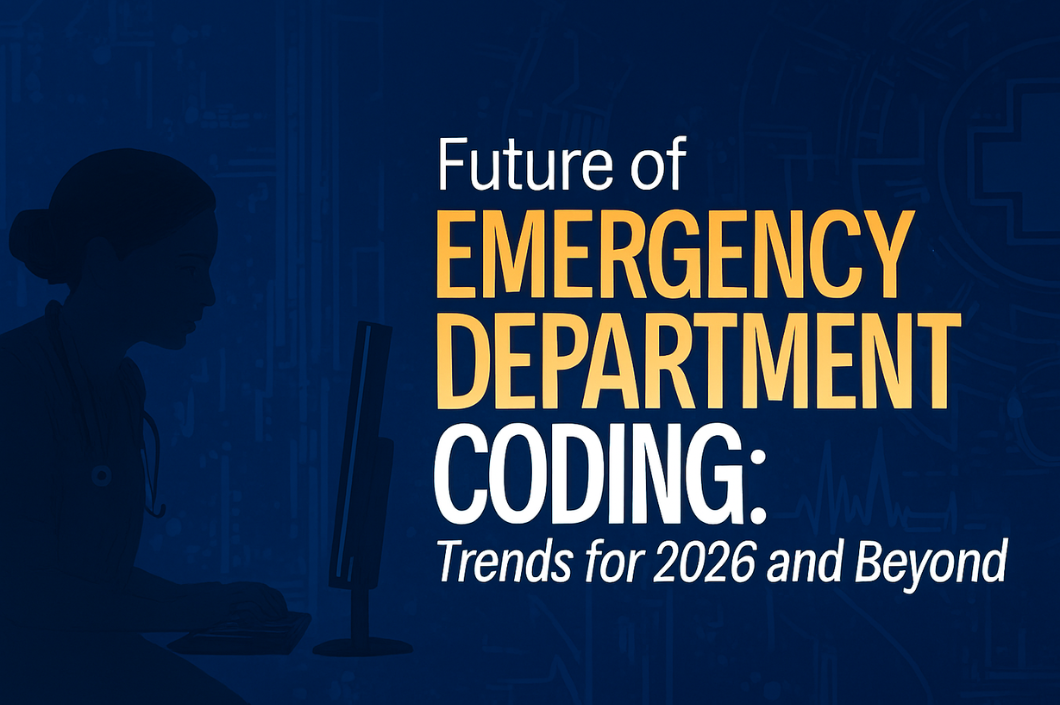The Emergency Department (ED) has always been one of the most dynamic areas in healthcare. With unpredictable patient volumes, urgent cases, and complex medical scenarios, accurate coding in the ED plays a critical role in both patient care and Revenue Cycle Management. As healthcare continues to evolve, so does the landscape of coding. Looking ahead to 2026 and beyond, several trends are shaping the future of emergency department coding, from technological advancements to regulatory updates.
In this blog, we will explore the emerging trends that are expected to redefine ED coding and what providers, coders, and healthcare organizations need to prepare for.
1. Growing Adoption of Artificial Intelligence (AI) in ED Coding
One of the most significant changes in medical coding, especially in emergency departments, is the rise of AI-enabled coding solutions. These tools can analyze documentation in real-time, assign suggested codes, and highlight missing elements that may cause denials.
For emergency departments, where speed and accuracy are critical, AI offers:
- Faster turnaround time for coding high-volume cases.
- Reduction in manual errors.
- Identification of documentation gaps before claims submission.
- Enhanced compliance with payer and CMS guidelines.
By 2026, AI is expected to become an integral part of ED workflows, allowing coders to focus more on reviewing complex cases and ensuring clinical accuracy.
2. Increased Focus on CDI (Clinical Documentation Integrity)
As payers continue to scrutinize ED claims, complete and accurate documentation will remain a top priority. CDI programs in the ED setting will help ensure that clinical notes support the medical necessity of services provided.
Future CDI coding strategies will rely on:
- Real-time physician prompts to improve documentation clarity.
- Concurrent CDI reviews to reduce downstream Claim Denials.
- Integration of CDI with AI and EHR systems.
By 2026, CDI in the ED will not only help improve coding accuracy but also strengthen compliance, reduce audit risks, and secure fair reimbursement.
3. Evolving Evaluation and Management (E/M) Coding Guidelines
Emergency departments often rely on E/M coding to bill for services, and recent guideline changes have shifted the focus from volume-based to complexity-based documentation. This trend will continue in 2026 and beyond.
Key changes to expect include:
- Greater emphasis on medical decision-making (MDM) over history and physical examination.
- Simplified documentation requirements for ED physicians.
- Ongoing adjustments from CMS to reduce administrative burden.
Coders and physicians will need to stay updated on these evolving guidelines to ensure compliance and accurate reimbursements.
4. Telehealth Expansion in the ED
Telehealth became mainstream during the COVID-19 pandemic, and it continues to play a role in emergency care. By 2026, tele-emergency medicine will be more widely adopted, especially in rural and underserved areas.
This expansion raises important coding considerations, such as:
- Specific telehealth E/M codes for emergency care.
- Documentation requirements for virtual visits.
- Compliance with state-specific telemedicine regulations.
ED coders must adapt to this shift and ensure that telehealth services are accurately captured and reimbursed.
5. Integration of Risk Adjustment in ED Coding
Traditionally, Risk Adjustment Coding has been more relevant in outpatient and primary care settings. However, with value-based care models expanding, ED visits are increasingly being factored into risk adjustment calculations.
Future ED coding will need to:
- Capture all relevant chronic conditions documented during ED encounters.
- Ensure accurate HCC (Hierarchical Condition Category) coding when applicable.
- Support payers in predicting costs and allocating resources more effectively.
By 2026, risk adjustment integration in ED coding will become a new standard.
6. Increased Use of Automation for Denial Prevention
Denials continue to be a major pain point for emergency departments. Automation, combined with predictive analytics, will play a key role in identifying and preventing denials before they occur.
Automated denial prevention tools will:
- Flag incomplete documentation in real-time.
- Match coding patterns against payer-specific rules.
- Provide alerts for potential compliance risks.
This shift will improve first-pass claim acceptance rates, reducing revenue leakage for EDs.
7. Focus on Compliance and Audit Preparedness
With regulatory bodies and payers tightening scrutiny, compliance will remain a top concern. By 2026, ED coding teams will need to adopt proactive audit readiness strategies.
This includes:
- Regular internal coding audits.
- Ongoing coder training on evolving guidelines.
- Use of compliance dashboards integrated with EHR systems.
Staying audit-ready will help EDs avoid penalties, recoupments, and compliance-related disruptions.
8. Increased Demand for Specialty-Specific ED Coding Expertise
Emergency departments handle a wide range of cases from trauma and pediatrics to cardiology and orthopedics. By 2026, the demand for specialty-trained coders in the ED will continue to grow.
Coders specializing in areas such as:
- Trauma care coding.
- Pediatric emergency coding.
- Critical care coding.
- Procedural services in ED.
This specialization will help improve accuracy, reduce errors, and maximize reimbursements.
9. Greater Collaboration Between Coders and Clinicians
Future ED coding will not be a siloed process. Instead, collaboration between coders, CDI specialists, and physicians will become the norm.
By 2026, expect to see:
- Coders embedded in ED workflows.
- Direct communication channels between physicians and coders.
- Real-time feedback loops to improve documentation quality.
This collaboration will help close documentation gaps and strengthen the overall revenue cycle.
10. Data-Driven Insights and Predictive Analytics
Finally, the future of ED coding will be powered by data-driven insights. Coding data will not only drive reimbursements but also provide valuable insights into:
- Patient care trends.
- Utilization of emergency services.
- Predictive modeling for staffing and resource allocation.
By combining coding data with predictive analytics, EDs will be able to improve efficiency, reduce costs, and enhance patient outcomes.
Conclusion
The future of emergency department coding is rapidly evolving, driven by technology, compliance demands, and value-based care models. By 2026 and beyond, ED coding will be defined by:
- AI-driven automation.
- Stronger CDI integration.
- Evolving E/M and telehealth guidelines.
- Risk adjustment expansion.
- Proactive denial prevention and compliance readiness.
Healthcare organizations that embrace these trends will be better equipped to handle the challenges of emergency care coding, minimize denials, and ensure sustainable financial performance.
At Alpine Pro Health, we specialize in ED coding services, CDI support, and AI-enabled solutions that empower providers to achieve accuracy, compliance, and revenue integrity.


